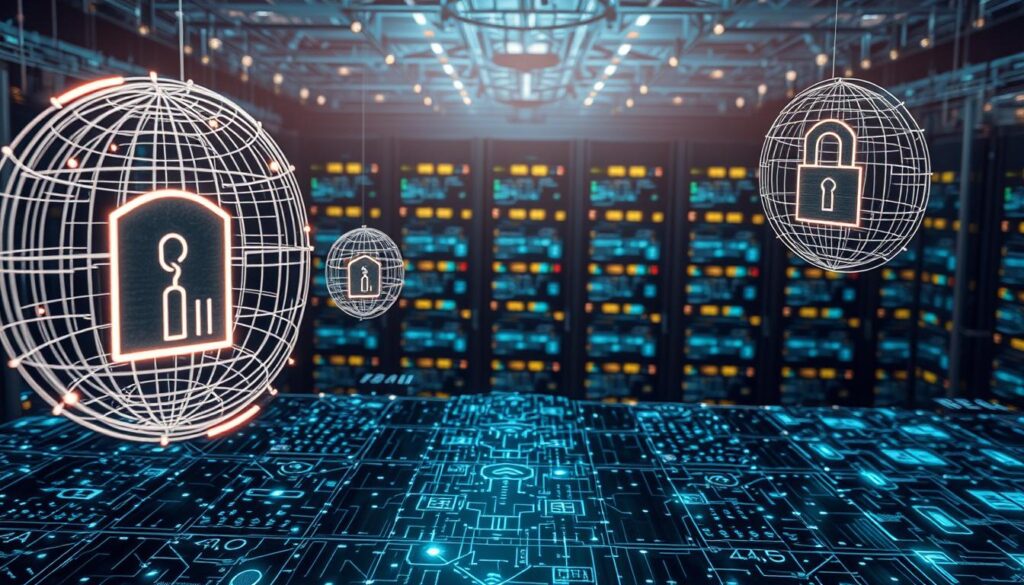What if a simple line of code could save your business over $220,000? That’s exactly what modern security measures can do. In today’s digital world, safeguarding sensitive information isn’t just an option—it’s a necessity.
From online banking to confidential emails, nearly 95% of web traffic relies on coded protection. This invisible shield transforms readable text into scrambled messages, blocking unauthorized access. The IBM 2023 report confirms it reduces breach costs by significant margins.
The technology has evolved dramatically since World War II’s Enigma Machine. Today’s systems combat sophisticated threats, including AI-powered attacks. With the global market projected to hit $20.1 billion by 2025, understanding these tools is crucial for every internet user.
Key Takeaways
- Encryption safeguards 95% of web traffic
- Reduces breach costs by $220,000+ on average
- Global market growing at 15.1% annually
- Protects against modern threats like ransomware
- Essential for both businesses and individuals
What Is Data Encryption?
Scrambling information into unreadable code is the backbone of digital security. This process, called encryption, uses advanced math to protect sensitive details from prying eyes. Whether it’s a credit card number or a medical record, encryption ensures only authorized parties can access the original content.
Definition and Core Concepts
At its core, encryption transforms readable text (plaintext) into scrambled output (ciphertext) using encryption algorithms. These algorithms, like AES-256 or 3DES, rely on secret keys to lock and unlock information. For example, AES-256 processes data in 128-bit blocks with 10-14 rounds of mixing—making it nearly unbreakable.
Not all methods are equal. Older standards like 56-bit DES were cracked in 22 hours, while AES-256 would take 100+ trillion years to brute-force. Modern systems follow Kerckhoffs’ Principle: security depends on key secrecy, not hiding the algorithm itself.
Plaintext vs. Ciphertext
Plaintext is the original message, like “Transfer $500.” Encryption converts it to ciphertext, such as “X9#kLmPqR2$%,” using keys. Format-preserving methods (FPE) keep structures intact—a phone number stays as XXX-XXX-XXXX even when encrypted.
- Block vs. Stream Ciphers: AES works in fixed blocks; RC4 encrypts data streams bit-by-bit.
- Hashing vs. Encryption: SHA-256 hashes are irreversible; AES allows decryption with the right key.
Why Data Encryption Matters: Key Benefits
Regulators now penalize companies up to $3.9M for failing to secure private records properly. Beyond avoiding fines, robust security safeguards trust and operational continuity. Here’s how encryption delivers critical advantages.
Promotes Data Integrity and Prevents Theft
Cybercriminals target unsecured files 266% more often, per recent malware reports. Encryption ensures data integrity by scrambling content, making theft useless without decryption keys.
For example, Signal’s user base grew by 40M after WhatsApp’s privacy policy changes. Its end-to-end encryption proved vital for protecting data from unauthorized access.
Supports Regulatory Compliance
Laws like HIPAA and GDPR require encryption for sensitive information. PCI DSS Requirement 3.4 explicitly mandates cardholder data protection during storage and transmission.
NIST SP 800-175B provides guidelines for validating cryptographic modules. Following these standards ensures compliance and reduces legal risks.
Protects Intellectual Property
AES-256 encryption shields trade secrets during product development. An unencrypted laptop led to a $3.9M HIPAA settlement—proof that weak security endangers assets.
GDPR Article 34 even exempts breach notifications if stolen data protection measures like encryption render files unreadable.
Symmetric vs. Asymmetric Encryption
Modern security systems rely on two fundamental approaches to lock down information: symmetric encryption and asymmetric encryption. While both transform readable content into secure code, their methods for handling encryption keys differ dramatically. Choosing the right approach depends on performance needs and security requirements.
Symmetric Encryption: Private Key Basics
The AES-256 algorithm demonstrates why symmetric encryption dominates high-speed applications, achieving 3.5GB/s throughput on modern processors. This method uses a single private key for both locking and unlocking information.
Financial institutions favor this approach for bulk transactions due to its speed advantage. OpenSSL benchmarks show AES operates 10x faster than RSA alternatives when processing large datasets.
Asymmetric Encryption: Public and Private Keys
Asymmetric encryption solves the key distribution problem through paired public keys and private keys. RSA-2048’s 6.4 quadrillion-year brute-force resistance makes it ideal for secure communications.
Elliptic Curve Cryptography (ECC-256) provides equivalent protection to RSA-3072 with smaller key sizes. This efficiency powers modern protocols like TLS 1.3 during the initial handshake phase.
Hybrid systems like PGP combine both approaches—using asymmetric for key exchange and symmetric for content protection. The Diffie-Hellman protocol elegantly solves the key exchange paradox without direct transmission.
NIST’s post-quantum cryptography project aims to future-proof these methods against emerging threats. Government standards like NSA Suite B already mandate specific combinations for classified communications.
Types of Data Encryption Algorithms
Behind every secure online transaction lies a powerful mathematical formula. Encryption algorithms are the engines that transform readable information into unbreakable code. They vary in speed, strength, and use cases—from safeguarding credit cards to securing military communications.
Symmetric Algorithms: Speed and Simplicity
AES-256 dominates this category, processing 128-bit blocks with 14 rounds of mixing. It’s the gold standard for bulk encrypt data tasks, achieving 3.5GB/s speeds on modern hardware. Blowfish, though older, remains popular for its flexibility with variable key lengths.
ChaCha20-Poly1305 outperforms AES on mobile devices, hitting 2.5GB/s. WireGuard VPNs leverage this for low-latency protection. NIST’s FIPS 140-3 validation ensures these modules meet strict security benchmarks.
Asymmetric Algorithms: Secure Key Exchange
RSA-2048 powers SSL TLS handshakes, but Ed25519 signatures verify 60% faster. OpenSSH now defaults to Ed25519 for its efficiency. ECC-256 offers RSA-3072-level security with smaller keys, ideal for constrained devices.
The NSA’s Commercial Suite mandates specific combinations for national security. Digital signatures rely on these methods to verify authenticity without exposing private keys.
- AES vs. ChaCha20: Choose AES for hardware acceleration, ChaCha20 for software efficiency.
- NIST SP 800-131A: Phased out RSA-1024, requiring 2048-bit minimums.
- LibreSSL: Prioritizes simplicity over OpenSSL’s legacy features.
Data Encryption Standards You Should Know
Government agencies and enterprises demand ironclad security protocols to safeguard critical systems. Two frameworks dominate this space: NIST’s FIPS certifications and the Common Criteria evaluations. These standards separate compliant solutions from risky alternatives.
NIST FIPS 140-3 Requirements
The updated FIPS 140-3 standard took effect in September 2021, introducing stricter testing through CMVP. It defines four security levels for cryptographic modules:
- Level 1: Basic requirements like AES-256 approval
- Level 2: Adds tamper-evident seals (Microsoft Azure meets this)
- Level 3: Physical tamper-resistance for HSMs
- Level 4: Military-grade protection against environmental attacks
PCI SSC still accepts FIPS 140-2 for payment systems until 2025. The validation process takes 12-18 months and costs $250k-$1M. Only approved algorithms like AES get certification—Blowfish remains excluded despite its use cases.
Common Criteria Evaluation Levels
Governments often require EAL4+ certification for procurement. The seven Evaluation Assurance Levels measure rigorous testing:
- EAL1: Functionally tested (consumer apps)
- EAL4+: Methodically designed and tested (Apple iOS)
- EAL7: Formally verified for nuclear systems
Unlike FIPS, Common Criteria assesses entire systems rather than modules. Apple’s EAL4+ certification covers their Secure Enclave hardware and software stack. This flexibility makes CC popular for complex implementations.
Data at Rest vs. Data in Transit
Every digital interaction creates two security challenges: protect data stored in devices and secure information moving across networks. While both states require safeguards, their protection methods differ significantly in implementation and standards.
Encrypting Stored Data
The AES-XTS standard (IEEE 1619) dominates disk data rest protection, preventing unauthorized access data even if hardware is stolen. AWS S3 now automatically applies this to 100% of stored objects since 2023.
Full-disk solutions like LUKS (Linux) and BitLocker (Windows) show minimal 3-5% performance overhead. iCloud’s expanded end-to-end encryption now covers 23 additional backup categories, setting new cloud security benchmarks.
Securing Data During Transfer
SSL TLS 1.3 slashes handshake latency by 300ms versus 1.2, while AES-GCM mode optimizes packet encryption. Let’s Encrypt certificates now secure 90% of web traffic by enabling free HTTPS adoption.
Advanced techniques like certificate pinning harden mobile apps against interception. The 0-RTT resumption in TLS 1.3 improves speed but requires careful implementation to prevent replay attacks.
Can Encrypted Data Be Hacked?
No system is 100% unhackable, but modern safeguards come close. While encrypted data is incredibly secure, determined attackers exploit weaknesses in implementation or outdated standards. Understanding these threats helps organizations stay ahead.
Common Attack Methods
Brute force attacks account for 63% of breaches, testing millions of password combinations. Quantum computers running Shor’s algorithm could someday crack RSA in seconds. The CRIME attack abuses TLS compression to steal cookies.
Older systems face unique risks. The Logjam flaw targets 512-bit Diffie-Hellman exchanges, while ROCA compromised Infineon’s TPM chips. Even password managers resist only ~1M guesses per second—highlighting the need for layered protection.
Mitigation Strategies
Hardware Security Modules (HSMs) block cold boot attacks by erasing keys during tampering. Cloudflare’s post-quantum tests combine NTRU and X25519 for future-proofing. NIST’s CNSA 2.0 timeline guides migration to quantum-resistant algorithms.
For nonce misuse, XChaCha20 outperforms AES-GCM-SIV in some scenarios. Always pair security updates with employee training—63% of breaches start with human error.
Cloud-Based Encryption Solutions
Cloud platforms now handle cryptographic operations at unprecedented scale, reshaping enterprise security. With AWS KMS processing 10M+ requests per second, these encryption solutions balance performance and protection. They eliminate the need for costly on-premise hardware while meeting strict compliance requirements.
Encryption as a Service (EaaS)
EaaS providers like AWS and Azure offload complex key management to secure cloud environments. Azure Confidential Computing uses Intel SGX enclaves to isolate sensitive processes, while Google Cloud’s External Key Manager integrates Thales HSMs for hardware-grade protection.
For regulatory needs, Azure’s Double Key Encryption holds one key in Microsoft’s cloud and another locally. This satisfies laws like GDPR by ensuring no single party can encrypt data independently. Snowflake’s tri-secret sharing adds another layer, requiring multiple approvals for access.
Bring Your Own Encryption (BYOE)
BYOE lets organizations retain control with customer-managed keys. Alibaba Cloud’s implementation faces challenges like cross-region key synchronization, but Cloudflare’s Geo Key Management automates data residency compliance. HashiCorp Vault offers a vendor-agnostic alternative to AWS KMS, ideal for multi-cloud setups.
Provider-managed keys simplify operations but limit customization. For industries like healthcare or finance, retaining ownership of cryptographic materials is often non-negotiable. The right choice depends on risk tolerance and infrastructure complexity.
Key Features of Effective Encryption Solutions
The average enterprise manages over 15,000 cryptographic keys—each requiring strict controls. Modern encryption solutions combine automated management with military-grade protection to secure systems at scale. Financial penalties for non-compliance now exceed $4M under updated PCI DSS rules.
Granular Controls and Key Management
PCI DSS Requirement 3.5 mandates documented procedures for encryption key management across their lifecycle. NIST SP 800-57 advises rotating RSA keys every 2-3 years, while FIPS 140-3 Level 3 demands physical tamper resistance for high-security deployments.
Kubernetes Secrets now automate rotation through external providers like AWS KMS. HashiCorp Vault implements Shamir’s Secret Sharing, splitting master keys across five administrators for breach protection. Thales CipherTrust uses policy-based controls to limit access data by role and location.
Always-On Encryption
Microsoft Purview applies message encryption automatically based on content scanning. Its workflow integrates with Azure Rights Management to protect sensitive information in emails and documents.
Row-level encryption in databases shows 15-20% performance overhead, but AWS CloudHSM reduces this to 5% through hardware acceleration. Quantum key distribution networks now secure inter-bank transfers for JPMorgan and Goldman Sachs.
When evaluating HSM vendors, Utimaco leads in government use cases while YubiHSM excels in IoT deployments. All solutions must balance compliance with operational efficiency in today’s threat landscape.
Emerging Trends in Data Encryption
Scientists are racing against quantum computers to future-proof our digital infrastructure. Breakthroughs in cryptographic research now address tomorrow’s security challenges while enabling revolutionary privacy features. Two innovations stand out in this transformation.
Quantum-Resistant Algorithms
NIST’s selection of CRYSTALS-Kyber marks a milestone in post-quantum standardization. This lattice-based approach withstands attacks from quantum processors that could crack RSA in minutes. The related CRYSTALS-Dilithium algorithm uses similar math for digital signatures with smaller key sizes.
DARPA’s SIEVE program explores encrypted AI training, while China’s Micius satellite tests quantum key distribution in space. IBM’s toolkit helps developers prepare for the quantum era with hybrid solutions that blend classical and post-quantum methods.
Homomorphic Encryption
Microsoft’s SEAL library processes SQL queries on encrypted databases without decryption—a game-changer for data protection. Zama’s fhEVM extends this to blockchain, enabling private smart contract execution.
Google’s Private Join framework performs analytics on encrypted datasets from multiple sources. Performance remains a challenge—fully homomorphic schemes like TFHE take 30 minutes per CNN inference versus BGV’s faster but less secure approach.
These advancements redefine what’s possible in secure computation while addressing emerging threats. Organizations should monitor these developments as they mature from labs to production environments.
Best Practices for Implementing Data Encryption
Enterprise security teams face a critical challenge: balancing robust protection with operational efficiency. Proper implementation requires aligning technical controls with business workflows while meeting compliance mandates. The CIS Critical Security Control 3 framework provides a proven roadmap for effective deployment.
Classifying Data Sensitivity
NIST SP 800-88 outlines tiered approaches for media sanitization based on information criticality. Financial records demand AES-256 with hardware HSMs, while internal documents may use AES-128. Microsoft Purview automates this process using AI-driven content scanning and labeling.
For PCI DSS compliance, tokenization often outperforms traditional encryption methods for payment data. The updated PCI PIN Security Requirements v3.0 mandate quarterly key rotation cycles and dual-control procedures for high-value assets.
Integrating with Existing Systems
IBM z16 mainframes now feature Crypto Express7S adapters that accelerate processing by 5x. Kubernetes CSI drivers enable transparent volume encryption without application modifications. Vormetric’s solution shows particular strength in hybrid cloud environments with centralized policy management.
Implementation costs vary significantly—FIPS 140-2 Level 2 validation starts at $500k. However, automated key rotation and hardware acceleration can reduce operational overhead by 40% annually. Always conduct proof-of-concept testing before enterprise-wide rollout.
Conclusion
Quantum computers will challenge current security by 2025, making upgrades urgent. Zero Trust architectures now rely on layered protection, with AI tools detecting anomalies faster than humans.
Automated key management platforms reduce risks, while FIPS 140-3 Level 4 prepares enterprises for stricter standards. Attack methods evolve constantly—complacency isn’t an option.
Start assessing your data encryption maturity today. Future-proof systems now to avoid costly breaches tomorrow.







